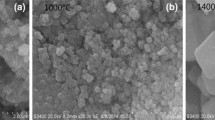Abstract
This study aimed to find an efficient way to recover Sb from the SbCl5 acid solution obtained by the chloride leaching process of the tin-depleted residue. Sb was recovered in the form of hydrated antimony pentoxide through the hydrolysis process. The effects of hydrolysis ratio and aging time on the Sb recovery process were studied, and the corresponding trends were established. The experimental results show that the amount of the antimony free ions increases with the hydrolysis ratio and aging time. This decreases the concentration quotient of the hydrolysis reaction and thus facilitates the reaction. Product crystallinity is affected by the solution supersaturation, which varies at different stages with aging time. As a result, the optimal conditions of recovering Sb correspond to the hydrolysis ratio of 1.5 and aging time of 7 days with the recovery rate of 97 %.





Similar content being viewed by others
References
Li B, Pan DA, Jiang YH. Recovery of copper and tin from stripping tin solution by electrodeposition. Rare Met. 2014;33(3):353.
Abdollahy M, Shafaei SZ. Optimized leaching conditions for selenium from SarCheshmeh copper anode slimes. Iran J Chem Chem Eng. 2004;23(2):101.
Anderson CG. Hydrometallurgically treating antimony-bearing industrial wastes. JOM. 2001;53(1):18.
Nordwick SM, Anderson CG. Advances in antimony electrowinning at the Sunshine mine. In: Proceedings of the Fourth International Symposium on Hydrometallurgy Fundamentals, Technology and Innovations, Salt Lake; 1993. 1107.
Xing WD, Fan XX, Dong HG. Kinetics of nickel and cobalt leaching from waste superalloys with sulfuric acid. Chin J Rare Met. 2014;38(4):674.
Macdonald MD, Stevens DA, Thibault JD. Process for producing antimony trioxide.US Patent; 5783166 A. 1998.
Motang T. New techniques for treating the Dachang jamesonite concentrate. J Cent South Inst Min Metall. 1981;198(4):18.
Nie ZR, Ma LW, Xi XL. “Complexation–precipitation” metal separation method system and its application in secondary resources. Rare Met. 2014;33(4):369.
Cao H, Chen J, Yuan H. Preparation of pure SbCl3 from lead anode slime bearing high antimony and low silver. Trans Nonferr Met Soc China. 2010;20(12):2397.
Neumann HM. Antimony (V) species in hydrochloric acid solution. J Am Chem Soc. 1954;76(10):2611.
Zheng G, Zhi B, Chen J. Hydrolysis of antimony pentachloride. Chin J Nonferr Met. 2006;16(9):1628.
Bullen CR, Mulvaney P. Nucleation and growth kinetics of CdSe nanocrystals in octadecene. Nano Lett. 2004;4(12):2303.
Seo H, Kim S. Development of NIR emitted CdTe quantum dots by concentration control method. Bull Korean Chem Soc. 2007;28(10):1637.
Wang F, Richards VN, Shields SP. Kinetics and mechanisms of aggregative nanocrystal growth. Chem Mater. 2013;26(1):5.
Richards VN, Shields SP, Buhro WE. Nucleation control in the aggregative growth of bismuth nanocrystals. Chem Mater. 2010;23(2):137.
Acknowledgments
The work was financially supported by the National Natural Science Foundation of China (Nos. U1360202 and 51472030), the National Key Project of the Scientific and Technical Support Program of China (Nos. 2011BAE13B07, 2012BAC02B01 and 2011BAC10B02), the National Hi-Tech R&D Program of China (No. 2012AA063202), the Fundamental Research Funds for the Central Universities (No. FRF-TP-14-043A1), the China Postdoctoral Science Foundation Funded Project (No. 2014M560885), the Beijing Nova Program (No. Z141103001814006) and Sichuan Province Cyclic Economy Research Center.
Author information
Authors and Affiliations
Corresponding author
Rights and permissions
About this article
Cite this article
Meng, L., Zhang, SG., Pan, DA. et al. Antimony recovery from SbCl5 acid solution by hydrolysis and aging. Rare Met. 34, 436–439 (2015). https://doi.org/10.1007/s12598-015-0480-y
Received:
Revised:
Accepted:
Published:
Issue Date:
DOI: https://doi.org/10.1007/s12598-015-0480-y




